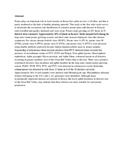| dc.contributor.author | Were, H K | |
| dc.contributor.author | Kabira, J N | |
| dc.contributor.author | Kinyua, Z M | |
| dc.contributor.author | Olubayo, F M | |
| dc.contributor.author | Karinga, J K | |
| dc.contributor.author | Aura, J | |
| dc.contributor.author | Lees, A K | |
| dc.contributor.author | Cowan, G H | |
| dc.contributor.author | Torrance, L | |
| dc.date.accessioned | 2014-08-18T11:22:30Z | |
| dc.date.available | 2014-08-18T11:22:30Z | |
| dc.date.issued | 2013-11 | |
| dc.identifier.citation | Were, H. K., Kabira, J. N., Kinyua, Z. M., Olubayo, F. M., Karinga, J. K., Aura, J., ... & Torrance, L. (2013). Occurrence and Distribution of Potato Pests and Diseases in Kenya. Potato Research, 56(4), 325-342. | en_US |
| dc.identifier.uri | http://hdl.handle.net/11295/73803 | |
| dc.description.abstract | Potato plays an important role in food security in Kenya but yields are low (<10 t/ha), and this is partly attributed to the lack of healthy planting material. This study is the first wide-scale survey to determine the occurrence and distribution of common potato pests and diseases in Kenyan seed (certified and quality declared) and ware crops. Potato crops growing on 101 farms in 21 districts were examined. Approximately 36% of plants in farmers’ fields sampled both during the long rains (main potato-growing season) and short rains seasons displayed virus-like disease symptoms. Six viruses (potato leafroll virus (PLRV), Potato virus A (PVA), potato virus M (PVM), potato virus S (PVS), potato virus X (PVX), and potato virus Y (PVY)) were detected using double antibody sandwich enzyme-linked immunosorbent assay in potato samples. Sequencing of polymerase chain reaction products from PVY-infected plants revealed the presence of recombinant strains of PVY (NTN and Wilga). Four aphid species, Macrosiphum euphorbiae, Aphis gossypii, Myzus persicae, and Aphis fabae, colonized potato in all districts, occurring in greater numbers west of the Great Rift Valley than to the east. There was a positive correlation between virus incidence and aphid numbers in the long rains (main) potato-growing season. PLRV, PVM, PVS, PVX, and PVY were detected in solanaceous weeds. Ralstonia solanacearum was detected in soils from 13 farms in 8 of the 18 districts surveyed. Approximately 38% of soil samples were infested with Meloidogyne spp. Phytophthora infestans isolates belonging to the US 1 and 2_A1 genotypes were identified. Although many economically important diseases are present in Kenya, the lower aphid incidence in districts east of the Great Rift Valley may indicate that these districts are more suitable for seed potato production. | en_US |
| dc.language.iso | en | en_US |
| dc.publisher | University Of Nairobi | en_US |
| dc.subject | Aphids . Bacterial wilt . Nematode . Phytophthora infestans . PVY. Solanum tuberosum | en_US |
| dc.title | Occurrence and Distribution of Potato Pests and Diseases in Kenya | en_US |
| dc.type | Article | en_US |
| dc.type.material | en_US | en_US |


